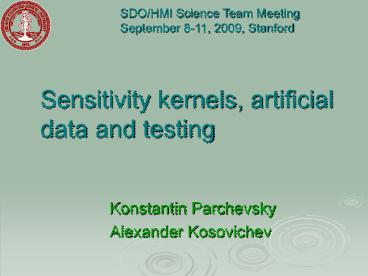SDO/HMI Science Team Meeting - PowerPoint PPT Presentation
Title:
SDO/HMI Science Team Meeting
Description:
Sensitivity kernels, artificial data and testing. Konstantin Parchevsky. Alexander Kosovichev ... Non-uniform background model (both horizontally and vertically) ... – PowerPoint PPT presentation
Number of Views:19
Avg rating:3.0/5.0
Title: SDO/HMI Science Team Meeting
1
SDO/HMI Science Team Meeting September 8-11,
2009, Stanford
Sensitivity kernels, artificial data and testing
Konstantin Parchevsky Alexander Kosovichev
2
Ray kernels
3
3D high resolution averagedsound speed ray
kernels
4
Plane parallel vs.spherical kernels
5
Born kernel
6
3D averaged sound speedBorn kernels
7
Ray and Born Kernels
8
Artificial data
- We developed 3D code for numerical simulation of
wave propagation inside the Sun (pure acoustics,
MHD, and MHDbackground velocities). - Non-uniform background model (both horizontally
and vertically) with non-uniform magnetic field
(for the magnetic instance of the code). User can
specify a profile of the sound speed
perturbation. - Localized single and multiple random sources.
User can specify the depth, size, frequency
range, type (force or pressure). - Additional damping (friction type term) can be
specified.
9
Characteristic featuresof the code
- We put great efforts to make results of
simulations as close to the real Sun as possible
for the linear code. - Dispersion-relation-preserving spatial scheme (
- Realistic top boundary condition (waves with
frequency higher than acoustic cut-off frequency
leave the domain). - Modification of the background state to remove
the convective instability.
10
k-? diagram
Verifies almost the entire code dispersion
relation, numerical dispersion, numerical
damping, boundary conditions, background
model, source spectrum. position of the
ridges, relative ridge ampl., overall power
distr., cut-off frequency.
11
Effect of non-uniform distribution of sources
Model I, wave field is masked
Model II, sources are masked
Model III, both wave field and sources are masked
Ann. radii 6.2-11.2, 8.7-14.5, 14.5-19.4 Mm
12
(No Transcript)
13
Conclusion
- Ray path and Born high-res. sensitivity kernels
are computed. - Linear 3D MHD code was developed and extensively
tested. - Artificial data (both pure acoustic magnetic)
for testing and calibration of helioseismic
techniques are ready for blind tests.































